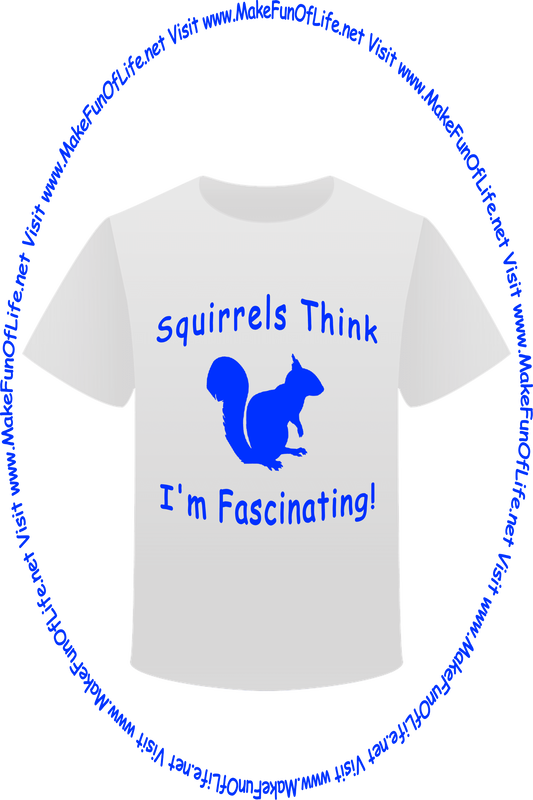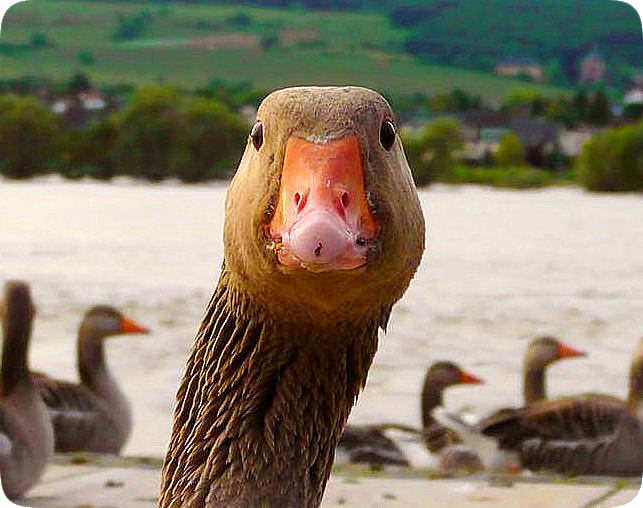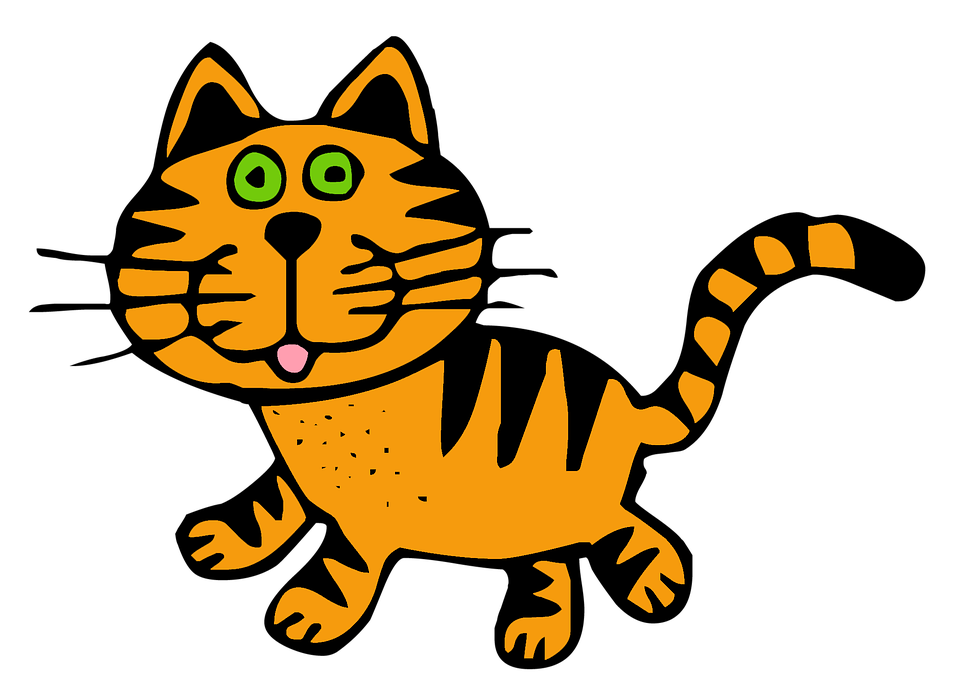A squirrel and a chipmunk - but how can you know for certain which is which?
Squirrels live in a variety of habitats. The three types of squirrels are tree squirrels (with bushy tails), ground squirrels (with non-bushy tails), and flying squirrels.
Well, now, let’s see . . . you’re bright-eyed and bushy-tailed? You are definitely a squirrel! Squirrels are known for their big bushy tails, which they use to balance themselves while they scamper around in trees and on the ground. They also use their tails to communicate in squirrel sign-language. For example, they can flick their tails when a dog is near to let other squirrels know to ‘scurry away to safety - pronto!’
“A squirrel is just a rat with a cuter outfit.” -Sarah Jessica Parker (born 1965)
Squirrels have tufts of hair on their pointed ears, large dark eyes, whiskers, claws on their feet, sharp teeth, powerful hind legs, and long bushy tails. They have five toes on their back feet and four toes on their front feet. Their front toes have sharp claws, which allow them to grip tree trunks. Their hind legs are double-jointed, which helps them run up and down trees very quickly.
Chipmunks are squirrels, strangely enough. Lively and speedy critters, chipmunks are diminutive members of the squirrel family. Their pudgy cheeks, large glossy eyes, stripes, and tails have made them a favorite among cartoonists, and have landed them starring roles in Hollywood productions (“Alvin and the Chipmunks,” for example). Their distinctive stripes have led to the term ‘timber tigers’ being humorously used as a nickname for them. We might think of chipmunks as the smaller and spunkier members of the squirrel family.
“Chipmunks are squirrels with racing stripes.” -David Hugh Beaumont (born 1966)
Chipmunks are the smallest members of the squirrel family, at about 17.78 to 27.94 centimeters (7 to 11 inches) long, including their long, bushy tails. They weigh roughly 28 to 142 grams (1 to 5 ounces). Chipmunks have gray-brown fur, with dark and light stripes along the back and light-colored undersides. Their eyes are surrounded by white fur, and they have dark brown stripes on their faces.
Skippy: What does a chipmunk do when it rains?
Buddy: It gets wet!
Squirrels (other than chipmunk ones) range in size from 13 to 92 centimeters (5 to 36 inches) long, including their tails. They weigh about 300 to 713 grams (10.58 ounces to 25.29 ounces). Gray squirrels have color phases that include black, red, albino, and a blending of red and black. The black phase tends to be more common further north.
If you still cannot tell the difference between a squirrel and a chipmunk, it might help to remember that the squirrel is the one with a moose for a best friend, while the chipmunk has stripes and can sing, just as they are shown in television shows and in movies. What, you say those ones are not real animals? You are joking, right? No?!
All squirrels, including the type of ground squirrels called chipmunks, have large expandable cheek pouches at the sides of their mouths, into which they can stuff considerable quantities of food, and then scamper off to ‘squirrel their food away’ in their secret hiding places.
Squirrels and Chipmunks Facts
- An adult male squirrel is called a buck.
- An adult female squirrel is called a doe.
- A young squirrel is called a pup, a kit, or a kitten.
- A group of squirrels is called a scurry or a squad.
- The sounds made by squirrels are called chirping and squeaking.
- Squirrels live in North America, Europe, Asia, and Africa.
- Squirrels in the wild can live for as long as 6 years.
- Squirrels in captivity can live for as long as 15 years.
- Chipmunks in the wild can live for as long as 3 years.
- Chipmunks in captivity can live for as long as 8 years.
The Squirrel
Whisky frisky,
Hippity hop
Up he goes
To the top!
Whirly twirly,
Round and round
Down he scampers
To the ground.
Furly, curly,
What a tail!
Tall as a feather,
Broad as a sail!
Where’s his supper?
In the shell,
Snap, cracky,
Out it fell.
by Author Unknown
A squirrel’s nest is called a dray or a drey. Squirrels usually build nests at or above the ground’s surface, often in holes in the trunks of trees. Chipmunks burrow underground to nest. Many chipmunks dig extensive burrows that can be more than 3.5 meters (11 feet) long. These burrows often have more than one entrance and have chambers, or rooms, in which chipmunks store large amounts of food for the Winter. Some chipmunks make nests in logs or in bushes.
Dorothy: How do you catch a squirrel?
Doris: Climb a tree and act like a nut.
Clive: How do you catch a European squirrel?
Kyle: Climb a tree and act like a ‘metric’ nut.
The Flying Squirrel
The flying squirrel is crazy.
Though he has no feathers (much less wings),
He scampers up into the tallest tree
And cries, “Toot-toot! I’m a parachute!”
And away off the highest branches he springs
Into empty air, spreading every hair,
His arms and legs spread wide to the side,
Till he lands with a thump that’s almost quiet . . .
Admire it, child, but don’t you try it!
by John Gardner (1933 - 1982): “A Child’s Bestiary” (1977), page 23
Why are flying squirrels not seen more often? Flying squirrels are nocturnal, meaning they prefer to be out and about and on the move when it is dark. They can climb high up into trees and then jump or leap, positioning all four legs so that their gliding membrane (skin) is fully spread out, and then they land on a tree branch or a tree trunk, using their tails as brakes. Yes, what you may have suspected is indeed true: ‘flying squirrels’ cannot actually fly; they can only glide through the air, at distances of up to 90 meters (295 feet). Should we change their name to ‘nocturnal gliding squirrels,’ or ‘night gliders,’ for short?
Humans have long been envious of the flying squirrels’ aerial skills. Base jumpers and skydivers have even developed special ‘wing suits’ that let them mimic flying squirrels. The suits work to slow their descent and allow them to control their maneuvering as they glide through the atmosphere. Then, at a distance well above the ground, these extreme sporters release parachutes to make a greatly slowed final descent to the Earth’s surface.
Squirrels are omnivores, or animals that eat both plants and animals. Squirrels will eat seeds, nuts, grains, leaves, flowers, fruit, tree bark, roots, bulbs, mushrooms, caterpillars, worms, insects, eggs, small birds, mice, and other small animals. By far, their favorite food is nuts such as acorns, followed closely by sunflower seeds. Urban-dwelling, or city, squirrels have adapted themselves to eating just about anything, including pizza, luncheon meats, bread, and other kinds of human foods. When their usual food is scarce, they must eat anything they can find to survive - but so far, there are no known instances of squirrels eating humans, not even people who have fallen asleep on park benches.
Biff: How does a nut feel when a squirrel chews on it?
Buffy: Nut so good!
Squirrels beware - human food is extremely bad for you. Icky caramel-covered popcorn, yucky salted peanuts, disgusting greasy oil-fried chips, cardboard-like pizza - stay away from such gastrointestinal nightmares! Just look at how these foods cause humans to have bizarre and unnatural shapes and mobility impairments - oh, the horror of it all! Squirrels, it’s best to stick to the diet nature intended for you. Nature knows best, after all.
“Please do not feed the squirrels. If you feed the squirrels, they will become overweight, and prone to disease. Their population will grow, and they will lose their ability to forage for food on their own. They will expect you to feed them and they will attack you if you do not. They will become like little welfare recipients, and you would not want to do this to them.” -Author Unknown: sign posted in Rocky Mountain National Park, United States of America
Why do squirrels hide their food? Gray squirrels and Fox squirrels hide their food in many places, so that if another squirrel or animal finds a part of their food, their entire winter’s supply of food is unlikely to be eaten by those other animals. Sometimes squirrels hide food temporarily until they can move it to a better location, in a technique known as ‘scatter hoarding.’ Red squirrels and Pine squirrels dig shallow pits, referred to as ‘middens,’ where they store the pinecones they gather. They then cover this food supply with leaves and other debris to create a cold, moist storage environment, which is a practice called ‘larder hoarding.’ Squirrels need hidden food reserves to provide them with meals during the parts of the year when food is less plentiful, particularly during the cold Winter season when most plants do not grow or are dormant.
Millions of trees around the world, and in some cases, entire forests, have been planted by squirrels stowing away food for later use. Squirrels gather and bury large numbers of nuts and seeds, and then forget where they have hidden some of them. After enough time in the ground, and with proper temperature, moisture, and sunlight, the nuts and seeds sprout and grow into trees.
The Chipmunk
My friends all know that I am shy
But the chipmunk is twice as shy as I
He moves with flickering indecision
Like stripes across a television
He’s like the shadow of a cloud
Or Emily Dickinson read out loud.
by Ogden Nash
Like other wildlife, squirrels are best admired from a distance. If you attempt to feed squirrels by holding food in your fingers or in the palm of your hand, you could find yourself with painful squirrel bites. Squirrels do not usually bite people on purpose, unless they are provoked into a situation where they believe their lives are in danger, or they are under duress because of traumatic memories from bad past encounters with humans or other animals. However, it should be noted that the eyes of squirrels are set into their heads in such a way that they can have difficulty seeing objects directly in front of their faces, so they might unintentionally confuse your fingers or your hand with the food you are offering to them, and consequently bite you when trying to grasp the food with their sharp rodent teeth. Additionally, although cute and furry and fun to watch, squirrels can also be carriers of highly contagious interspecies diseases. If you are bitten or scratched by a squirrel or other wild animal, you will need to go to a hospital right away to get tetanus and rabies vaccination injections, as well as treatment for possible bubonic plague, as a precaution against contracting these diseases, which can be transmitted from squirrels to humans and can result in serious, even life-threatening, illnesses. This information is not intended to take the fun out of your visit to the park or your enjoyment of having a backyard squirrel feeding station, but it is intended to inform you of the potential risks of human-squirrel (and other human-wildlife) interactions.
Bert: How can you tell when a squirrel has been hiding its acorns in your chocolate pudding?
Bret: The pudding will be lumpier than usual.
The largest concentration of squirrels in the United States of America is in the nation’s capital, which is Washington in the District of Columbia, specifically in Lafayette Park near the White House. In this ‘Squirrel Capital of the World,’ the little rodents roam free and are well fed by thousands of government employees, tourists, and other visitors who share the park with the squirrels every day.
“This is a Tale about a tail - a tail that belonged to a little red squirrel, and his name was Nutkin.” -Beatrix Potter (Helen Beatrix ‘Beatrix’ Potter (1866 - 1943)): “The Tale of Squirrel Nutkin” (1903)
The word ‘squirrel’ comes from the Greek word ‘skiouros’ meaning ‘shadow tail.’
“I knew I was nuts the day the squirrels started looking at me funny.” -Author Unknown
A squirrel’s four front teeth never stop growing. Their teeth are worn down when they chomp on nuts and tree bark.
Squirrels have excellent eyesight. The large eyes of squirrels help them avoid predators.
The predators of squirrels, or animals that hunt and eat them, include bears, coyotes, eagles, foxes, hawks, domestic cats, humans, lynxes, owls, raccoons, snakes, and weasels.
When squirrels are frightened, they run back and forth and in different directions to confuse predators.
Some squirrels can run at speeds of up to 32 kilometers (20 miles) an hour, and some squirrels can jump distances of up to 6 meters (20 feet).
There are about 280 species of squirrels, including 25 species of chipmunks. They could all be living in your attic right now, filling the space between the walls and under the floor with nuts and nesting material, chewing the insulation off wires, and chewing holes in the walls to make entrances and exits. Additionally, they are not paying any rent money to you.
Squirrels and Chipmunks Quiz
- Where do squirrels live?
- Are squirrels chipmunks, or are chipmunks squirrels?
- What do squirrels eat?
Riddle: I scurry around gathering acorns and storing them for the Winter - who am I?
Solution: I am a squirrel.
Squirrels and Chipmunks Quiz Answers
- Squirrels make their homes below ground or up in trees.
- Chipmunks are small squirrels with striped fur.
- Squirrels are omnivores, and they eat plant material and animals including insects.
Squirrels
Squirrels do not watch
ridiculous late-night TV,
And that is why they are
smarter than you and me.
by David Hugh Beaumont (born 1966)
This is MFOL! . . . are you having as much fun today as squirrels are having?
Squirrels live in a variety of habitats. The three types of squirrels are tree squirrels (with bushy tails), ground squirrels (with non-bushy tails), and flying squirrels.
Well, now, let’s see . . . you’re bright-eyed and bushy-tailed? You are definitely a squirrel! Squirrels are known for their big bushy tails, which they use to balance themselves while they scamper around in trees and on the ground. They also use their tails to communicate in squirrel sign-language. For example, they can flick their tails when a dog is near to let other squirrels know to ‘scurry away to safety - pronto!’
“A squirrel is just a rat with a cuter outfit.” -Sarah Jessica Parker (born 1965)
Squirrels have tufts of hair on their pointed ears, large dark eyes, whiskers, claws on their feet, sharp teeth, powerful hind legs, and long bushy tails. They have five toes on their back feet and four toes on their front feet. Their front toes have sharp claws, which allow them to grip tree trunks. Their hind legs are double-jointed, which helps them run up and down trees very quickly.
Chipmunks are squirrels, strangely enough. Lively and speedy critters, chipmunks are diminutive members of the squirrel family. Their pudgy cheeks, large glossy eyes, stripes, and tails have made them a favorite among cartoonists, and have landed them starring roles in Hollywood productions (“Alvin and the Chipmunks,” for example). Their distinctive stripes have led to the term ‘timber tigers’ being humorously used as a nickname for them. We might think of chipmunks as the smaller and spunkier members of the squirrel family.
“Chipmunks are squirrels with racing stripes.” -David Hugh Beaumont (born 1966)
Chipmunks are the smallest members of the squirrel family, at about 17.78 to 27.94 centimeters (7 to 11 inches) long, including their long, bushy tails. They weigh roughly 28 to 142 grams (1 to 5 ounces). Chipmunks have gray-brown fur, with dark and light stripes along the back and light-colored undersides. Their eyes are surrounded by white fur, and they have dark brown stripes on their faces.
Skippy: What does a chipmunk do when it rains?
Buddy: It gets wet!
Squirrels (other than chipmunk ones) range in size from 13 to 92 centimeters (5 to 36 inches) long, including their tails. They weigh about 300 to 713 grams (10.58 ounces to 25.29 ounces). Gray squirrels have color phases that include black, red, albino, and a blending of red and black. The black phase tends to be more common further north.
If you still cannot tell the difference between a squirrel and a chipmunk, it might help to remember that the squirrel is the one with a moose for a best friend, while the chipmunk has stripes and can sing, just as they are shown in television shows and in movies. What, you say those ones are not real animals? You are joking, right? No?!
All squirrels, including the type of ground squirrels called chipmunks, have large expandable cheek pouches at the sides of their mouths, into which they can stuff considerable quantities of food, and then scamper off to ‘squirrel their food away’ in their secret hiding places.
Squirrels and Chipmunks Facts
- An adult male squirrel is called a buck.
- An adult female squirrel is called a doe.
- A young squirrel is called a pup, a kit, or a kitten.
- A group of squirrels is called a scurry or a squad.
- The sounds made by squirrels are called chirping and squeaking.
- Squirrels live in North America, Europe, Asia, and Africa.
- Squirrels in the wild can live for as long as 6 years.
- Squirrels in captivity can live for as long as 15 years.
- Chipmunks in the wild can live for as long as 3 years.
- Chipmunks in captivity can live for as long as 8 years.
The Squirrel
Whisky frisky,
Hippity hop
Up he goes
To the top!
Whirly twirly,
Round and round
Down he scampers
To the ground.
Furly, curly,
What a tail!
Tall as a feather,
Broad as a sail!
Where’s his supper?
In the shell,
Snap, cracky,
Out it fell.
by Author Unknown
A squirrel’s nest is called a dray or a drey. Squirrels usually build nests at or above the ground’s surface, often in holes in the trunks of trees. Chipmunks burrow underground to nest. Many chipmunks dig extensive burrows that can be more than 3.5 meters (11 feet) long. These burrows often have more than one entrance and have chambers, or rooms, in which chipmunks store large amounts of food for the Winter. Some chipmunks make nests in logs or in bushes.
Dorothy: How do you catch a squirrel?
Doris: Climb a tree and act like a nut.
Clive: How do you catch a European squirrel?
Kyle: Climb a tree and act like a ‘metric’ nut.
The Flying Squirrel
The flying squirrel is crazy.
Though he has no feathers (much less wings),
He scampers up into the tallest tree
And cries, “Toot-toot! I’m a parachute!”
And away off the highest branches he springs
Into empty air, spreading every hair,
His arms and legs spread wide to the side,
Till he lands with a thump that’s almost quiet . . .
Admire it, child, but don’t you try it!
by John Gardner (1933 - 1982): “A Child’s Bestiary” (1977), page 23
Why are flying squirrels not seen more often? Flying squirrels are nocturnal, meaning they prefer to be out and about and on the move when it is dark. They can climb high up into trees and then jump or leap, positioning all four legs so that their gliding membrane (skin) is fully spread out, and then they land on a tree branch or a tree trunk, using their tails as brakes. Yes, what you may have suspected is indeed true: ‘flying squirrels’ cannot actually fly; they can only glide through the air, at distances of up to 90 meters (295 feet). Should we change their name to ‘nocturnal gliding squirrels,’ or ‘night gliders,’ for short?
Humans have long been envious of the flying squirrels’ aerial skills. Base jumpers and skydivers have even developed special ‘wing suits’ that let them mimic flying squirrels. The suits work to slow their descent and allow them to control their maneuvering as they glide through the atmosphere. Then, at a distance well above the ground, these extreme sporters release parachutes to make a greatly slowed final descent to the Earth’s surface.
Squirrels are omnivores, or animals that eat both plants and animals. Squirrels will eat seeds, nuts, grains, leaves, flowers, fruit, tree bark, roots, bulbs, mushrooms, caterpillars, worms, insects, eggs, small birds, mice, and other small animals. By far, their favorite food is nuts such as acorns, followed closely by sunflower seeds. Urban-dwelling, or city, squirrels have adapted themselves to eating just about anything, including pizza, luncheon meats, bread, and other kinds of human foods. When their usual food is scarce, they must eat anything they can find to survive - but so far, there are no known instances of squirrels eating humans, not even people who have fallen asleep on park benches.
Biff: How does a nut feel when a squirrel chews on it?
Buffy: Nut so good!
Squirrels beware - human food is extremely bad for you. Icky caramel-covered popcorn, yucky salted peanuts, disgusting greasy oil-fried chips, cardboard-like pizza - stay away from such gastrointestinal nightmares! Just look at how these foods cause humans to have bizarre and unnatural shapes and mobility impairments - oh, the horror of it all! Squirrels, it’s best to stick to the diet nature intended for you. Nature knows best, after all.
“Please do not feed the squirrels. If you feed the squirrels, they will become overweight, and prone to disease. Their population will grow, and they will lose their ability to forage for food on their own. They will expect you to feed them and they will attack you if you do not. They will become like little welfare recipients, and you would not want to do this to them.” -Author Unknown: sign posted in Rocky Mountain National Park, United States of America
Why do squirrels hide their food? Gray squirrels and Fox squirrels hide their food in many places, so that if another squirrel or animal finds a part of their food, their entire winter’s supply of food is unlikely to be eaten by those other animals. Sometimes squirrels hide food temporarily until they can move it to a better location, in a technique known as ‘scatter hoarding.’ Red squirrels and Pine squirrels dig shallow pits, referred to as ‘middens,’ where they store the pinecones they gather. They then cover this food supply with leaves and other debris to create a cold, moist storage environment, which is a practice called ‘larder hoarding.’ Squirrels need hidden food reserves to provide them with meals during the parts of the year when food is less plentiful, particularly during the cold Winter season when most plants do not grow or are dormant.
Millions of trees around the world, and in some cases, entire forests, have been planted by squirrels stowing away food for later use. Squirrels gather and bury large numbers of nuts and seeds, and then forget where they have hidden some of them. After enough time in the ground, and with proper temperature, moisture, and sunlight, the nuts and seeds sprout and grow into trees.
The Chipmunk
My friends all know that I am shy
But the chipmunk is twice as shy as I
He moves with flickering indecision
Like stripes across a television
He’s like the shadow of a cloud
Or Emily Dickinson read out loud.
by Ogden Nash
Like other wildlife, squirrels are best admired from a distance. If you attempt to feed squirrels by holding food in your fingers or in the palm of your hand, you could find yourself with painful squirrel bites. Squirrels do not usually bite people on purpose, unless they are provoked into a situation where they believe their lives are in danger, or they are under duress because of traumatic memories from bad past encounters with humans or other animals. However, it should be noted that the eyes of squirrels are set into their heads in such a way that they can have difficulty seeing objects directly in front of their faces, so they might unintentionally confuse your fingers or your hand with the food you are offering to them, and consequently bite you when trying to grasp the food with their sharp rodent teeth. Additionally, although cute and furry and fun to watch, squirrels can also be carriers of highly contagious interspecies diseases. If you are bitten or scratched by a squirrel or other wild animal, you will need to go to a hospital right away to get tetanus and rabies vaccination injections, as well as treatment for possible bubonic plague, as a precaution against contracting these diseases, which can be transmitted from squirrels to humans and can result in serious, even life-threatening, illnesses. This information is not intended to take the fun out of your visit to the park or your enjoyment of having a backyard squirrel feeding station, but it is intended to inform you of the potential risks of human-squirrel (and other human-wildlife) interactions.
Bert: How can you tell when a squirrel has been hiding its acorns in your chocolate pudding?
Bret: The pudding will be lumpier than usual.
The largest concentration of squirrels in the United States of America is in the nation’s capital, which is Washington in the District of Columbia, specifically in Lafayette Park near the White House. In this ‘Squirrel Capital of the World,’ the little rodents roam free and are well fed by thousands of government employees, tourists, and other visitors who share the park with the squirrels every day.
“This is a Tale about a tail - a tail that belonged to a little red squirrel, and his name was Nutkin.” -Beatrix Potter (Helen Beatrix ‘Beatrix’ Potter (1866 - 1943)): “The Tale of Squirrel Nutkin” (1903)
The word ‘squirrel’ comes from the Greek word ‘skiouros’ meaning ‘shadow tail.’
“I knew I was nuts the day the squirrels started looking at me funny.” -Author Unknown
A squirrel’s four front teeth never stop growing. Their teeth are worn down when they chomp on nuts and tree bark.
Squirrels have excellent eyesight. The large eyes of squirrels help them avoid predators.
The predators of squirrels, or animals that hunt and eat them, include bears, coyotes, eagles, foxes, hawks, domestic cats, humans, lynxes, owls, raccoons, snakes, and weasels.
When squirrels are frightened, they run back and forth and in different directions to confuse predators.
Some squirrels can run at speeds of up to 32 kilometers (20 miles) an hour, and some squirrels can jump distances of up to 6 meters (20 feet).
There are about 280 species of squirrels, including 25 species of chipmunks. They could all be living in your attic right now, filling the space between the walls and under the floor with nuts and nesting material, chewing the insulation off wires, and chewing holes in the walls to make entrances and exits. Additionally, they are not paying any rent money to you.
Squirrels and Chipmunks Quiz
- Where do squirrels live?
- Are squirrels chipmunks, or are chipmunks squirrels?
- What do squirrels eat?
Riddle: I scurry around gathering acorns and storing them for the Winter - who am I?
Solution: I am a squirrel.
Squirrels and Chipmunks Quiz Answers
- Squirrels make their homes below ground or up in trees.
- Chipmunks are small squirrels with striped fur.
- Squirrels are omnivores, and they eat plant material and animals including insects.
Squirrels
Squirrels do not watch
ridiculous late-night TV,
And that is why they are
smarter than you and me.
by David Hugh Beaumont (born 1966)
This is MFOL! . . . are you having as much fun today as squirrels are having?































































































































